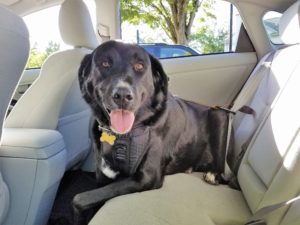
AAA Mid-Atlantic is reminding motorists that keeping their pets safe while driving also helps keep them and others sharing the road safe, too.
“As a proponent of traffic safety, AAA reminds drivers that the safety of their passengers, including those with four legs, should always be a priority,” said Kathleen Miller, senior public affairs specialist for AAA Mid-Atlantic. “No matter how long or short your drive is, it is crucial that your pets be restrained while inside your vehicle, keeping your animals safe and you as the driver, from being distracted.”
The National Highway Transportation Safety Administration (NHTSA) reports that in 2015 alone, there were more than 32,000 fatal crashes. Of those, ten percent of fatal crashes, 15 percent of injury crashes, and 14 percent of all police-reported motor vehicle traffic were reported as distraction-affected crashes. Even if your pet is well-behaved at home, in an exciting and different environment, like a trip in the car, they may forget all of their training and become excited or frightened. Having your pet roaming free in the front or back seat, even in your lap, is a huge distraction, especially if they start to cry or try to escape.
AAA Mid-Atlantic teamed up with the University of Pennsylvania School of Veterinary Medicine (Penn Vet) to offer the following tips for safe travel with your pets:
Fitting Your Pet into the Proper Restraint System
- The most important aspect of harness restraint systems is making sure they fit properly.Take your dogs’ chest and neck measurements and use this with his or her weight to make sure you have the proper size.
- You want to be able to fit two stacked fingers in between the harness and your dog.
- Make sure the harness does not choke your dog when he or she pulls.
- Acclimate your pet to the crate/carrier so he/she sees it as a cozy den, not a place of exile.
- Make sure the crate/carrier you choose is well ventilated.
- The crate/carrier should have enough room for your pet to stand and turn around in, but not so much room that he/she could be tossed about inside should you stop suddenly on the road.
- Place the crate/carrier somewhere secure in the car to make sure it doesn’t slide around and isn’t placed on top of something from which it could fall.
- Even if you think your cat or dog doesn’t like the carrier, he/she will be much more comfortable, safe, and less distracting than if free in the car.
Preparing Your Pet for Travel
- Get a clean bill of health from your veterinarian and make sure your pet is in good physical shape overall, especially if you are planning an active vacation.
- Make sure your pets’ vaccinations are up-to-date and obtain a health certificate showing proof of up-to-date vaccines, particularly rabies, distemper, and kennel cough. Ask your vet about potential health risks at your destination and the necessary preventative measures.
- Many pets take to the car without issue, but some associate the inside of the carrier or the car with a visit to the V-E-T. Get your pet used to the car without actually going anywhere first, then take short trips to places your pet enjoys, such as the park.
- To prevent car sickness, feed your pet four to six hours before departing. Talk to your veterinarian if your pet gets carsick.
- Don’t let your dog stick his/her head out the window, no matter how enjoyable it seems. Road debris and flying objects can injure delicate eyes and ears, and your animal is at greater risk for severe injury if the vehicle should stop suddenly or be struck.
- Stop every four hours to let your pet have a drink and a chance to answer the call of nature.
- Be sure your pet is leashed BEFORE opening the door at your rest stop. It will prevent him/her from unexpectedly breaking free and running away.
- If your pet does not enjoy a car ride, leave him/her at home.
“Being prepared and keeping your pets safe while traveling is extremely important and will make the trip more enjoyable for all,” said Dr. Deborah Mandell, clinical professor of Emergency and Clinical Care at Penn Vet’s Ryan Hospital.
Find more pet travel tips, videos and helpful links at aaa.com/pettravel.





